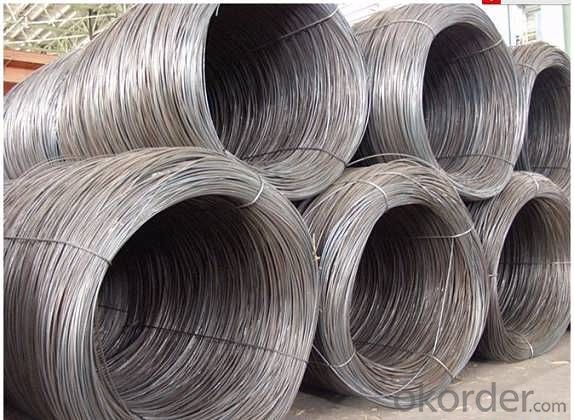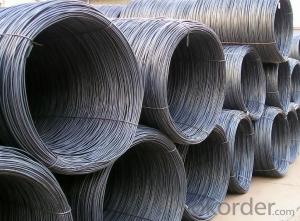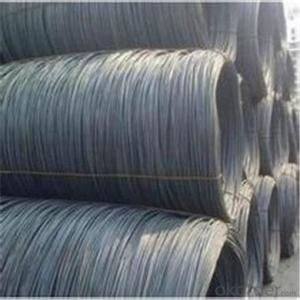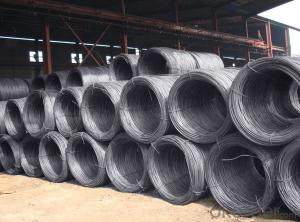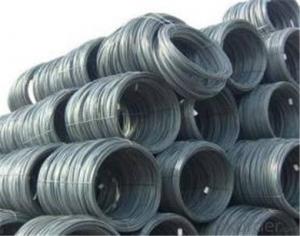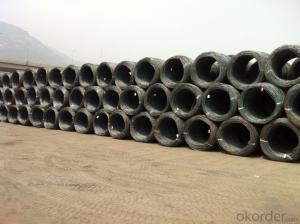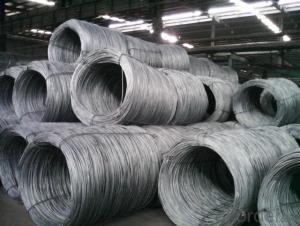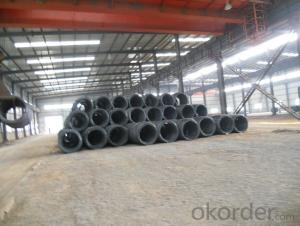High Quality Steel Wire Rod SAE1008 6.5mm
- Loading Port:
- Tianjin
- Payment Terms:
- TT or LC
- Min Order Qty:
- 50 m.t
- Supply Capability:
- 10000 m.t/month
OKorder Service Pledge
OKorder Financial Service
You Might Also Like
High Quality Steel Wire Rod SAE1008 6.5mm
Product Description:
Specifications of Wire Rod SAE1008:
Grade: SAE1008 Standard: ASTM
Diameter: 6.5mm
Alloy or Not: Alloy
Technique: Hot Rolled Place of Origin: China Mainland
Chemical Composition:
Please kindly find our chemistry of our material based on SAE1008 as below for your reference:
Grade | Chemical Composition (%) | |||||
C | Mn | S | P | Si | ||
SAE1008 | 0.10max | 0.32max | 0.045max | 0.040max | 0.30max | |
Mechanical properties | ||||||
Yield strength(N/mm2) | Tensile strength(N/mm2) | Elongation (%) | ||||
≥195 | 350-380 | ≥32 | ||||
Usage and Applications of High Quality Steel Wire Rod SAE1008 6.5mm:
After hot-rolled the products shaped into coil and delivery as finished product, including round, square,rectangular, hexagonal and so on. Since most of the products are round, it is generally called wire rod. Carbon steel wire rod is widely used in construction and manufacturing. Carbon steel wire rod is mainly used for reinforcement of reinforced concrete and welded structure or reprocessed (roberts , nail, etc.) materials, especially used to produce wire drawing, welding electrode, nails, spring, electronic, precise machinery parts and so on.
Packaging & Delivery of High Quality Steel Wire Rod SAE1008 6.5mm:
Packaging Detail: products are packed in coil and then shipped by container or bulk vessel
Each coil weight: About 2.05MT
Delivery Detail: within 45 days after received deposit or LC.
Label: to be specified by customer, generally, each bundle has 1-2 labels
Trade terms: FOB, CFR, CIF
FAQ:
Q1: Why buy Materials & Equipment from OKorder.com?
A1: All products offered byOKorder.com are carefully selected from China's most reliable manufacturing enterprises. Through its ISO certifications, OKorder.com adheres to the highest standards and a commitment to supply chain safety and customer satisfaction.
Q2: How do we guarantee the quality of our products?
A2: We have established an advanced quality management system which conducts strict quality tests at every step, from raw materials to the final product. At the same time, we provide extensive follow-up service assurances as required.
Q3: How soon can we receive the product after purchase?
A3: Within three days of placing an order, we will arrange production. The shipping date is dependent upon the quatity, how many sizes you want and the plan of production, but is typically 1 month to 2 month days from the beginning of production.
Images of High Quality Steel Wire Rod SAE1008 6.5mm:
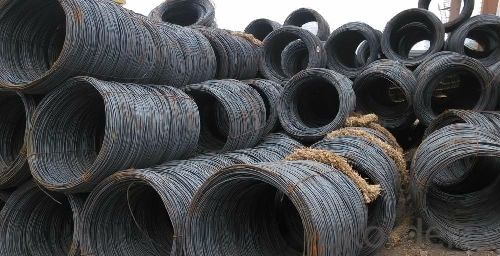

*If you would like to get our price, please inform us the size, standard/material and quantity. Thank you very much for your attention.
- Q: How does the ductility of steel wire rod vary with different wire drawing processes?
- The ductility of steel wire rod can vary with different wire drawing processes. Generally, the wire drawing process involves pulling the wire rod through a series of dies to reduce its diameter. This process can increase the length of the wire rod while reducing its cross-sectional area. The ductility of the steel wire rod can be affected by several factors during the wire drawing process, such as the number of drawing passes, the speed of the drawing process, and the temperature at which it is performed. In certain cases, an increased number of drawing passes can lead to enhanced ductility as it allows for a more uniform reduction in diameter and a better alignment of the crystal structure. However, excessive drawing passes can also lead to work hardening and reduce the overall ductility of the wire rod. The speed of the wire drawing process can also impact ductility. Higher drawing speeds can result in increased strain rates, which can affect the mechanical properties of the wire rod. Slower drawing speeds, on the other hand, can allow for more controlled deformation and improved ductility. Additionally, the temperature at which the wire drawing is performed can influence ductility. Higher temperatures can enhance the ductility of the steel wire rod by reducing the strain hardening effect. However, excessive temperatures can also lead to undesirable grain growth and decrease the strength of the wire rod. Overall, the ductility of steel wire rod can vary with different wire drawing processes, and it is essential to optimize the drawing parameters to achieve the desired mechanical properties.
- Q: What are the main factors influencing the choice of steel wire rod order payment method?
- The main factors influencing the choice of steel wire rod order payment method can vary depending on the specific circumstances and preferences of the parties involved. However, some common factors that often come into play include: 1. Transaction volume and frequency: If the buyer and seller have a long-term and high-volume relationship, they may opt for a more convenient and efficient payment method such as open account or letter of credit. This allows for smoother and quicker transactions without the need for repetitive paperwork or bank involvement. 2. Trust and creditworthiness: If there is a lack of trust between the buyer and seller, or if the buyer's creditworthiness is questionable, the seller may prefer more secure payment methods such as advance payment or documentary collection. These methods provide a level of assurance that the payment will be made before the goods are delivered. 3. Cost and convenience: The cost and convenience of different payment methods can also influence the choice. For instance, if the buyer wants to avoid additional fees or charges associated with certain payment methods, they may opt for methods like cash in advance or electronic funds transfer. On the other hand, if the seller wants to minimize the administrative burden or costs of payment processing, they may prefer open account or electronic payments. 4. Country-specific regulations and customs: Different countries have their own regulations and customs when it comes to international trade and payment methods. For example, certain countries may have restrictions on certain payment methods or require specific documentation for customs clearance. Sellers and buyers need to consider these factors when choosing the payment method. 5. Payment security and risk mitigation: The level of payment security and risk mitigation desired by the buyer and seller can also influence the choice of payment method. Methods such as letter of credit or documentary collection provide a higher level of security and risk mitigation compared to methods like open account or cash in advance. 6. Market norms and industry practices: The prevailing market norms and industry practices may also influence the choice of payment method. For instance, in certain industries or regions, it may be common to use specific payment methods due to historical practices or preferences. In conclusion, the main factors influencing the choice of steel wire rod order payment method include transaction volume and frequency, trust and creditworthiness, cost and convenience, country-specific regulations and customs, payment security and risk mitigation, as well as market norms and industry practices. It is essential for both the buyer and seller to carefully evaluate these factors to select the most suitable payment method for their specific situation.
- Q: How is steel wire rod used in the manufacturing of wire for electrical heating cables?
- Steel wire rod is an essential component in the manufacturing process of wire for electrical heating cables. The wire rod serves as the primary raw material that undergoes various treatments and transformations to produce the final electrical heating cable wire. To begin with, the steel wire rod is typically made from low-carbon steel, which possesses excellent electrical conductivity and heat resistance properties. This makes it an ideal material for electrical heating cables, as it can efficiently conduct electricity and withstand the high temperatures generated by the cables. The first step in the manufacturing process involves hot rolling the steel wire rod into a thin strip, which is then cold drawn to achieve the desired wire diameter. This cold drawing process imparts high tensile strength and flexibility to the wire, ensuring it can withstand the stress and strain associated with various applications. Once the wire is formed, it is then subject to a series of heat treatments to enhance its electrical conductivity and heat resistance. This may involve annealing, where the wire is heated and slowly cooled to relieve internal stresses and improve its ductility. Additionally, the wire may be subjected to a process called galvanization, which involves coating the wire with a protective layer of zinc to enhance its corrosion resistance. After the heat treatments, the wire is further processed to achieve the required specifications for electrical heating cables. This may involve additional drawing processes to achieve the desired diameter and surface finish. The wire is then wound onto spools or coils, ready to be used in the manufacturing of electrical heating cables. In the final stage of the manufacturing process, the steel wire is incorporated into the construction of electrical heating cables. This typically involves combining the wire with other materials, such as insulation and protective sheathing, to ensure the safety and functionality of the cables. Overall, steel wire rods play a crucial role in the manufacturing of wire for electrical heating cables. Its excellent electrical conductivity, heat resistance, and strength make it an ideal material for this application. Through various treatments and processes, the steel wire rod is transformed into a high-quality wire that can efficiently conduct electricity and withstand the demanding conditions of electrical heating systems.
- Q: How is steel wire rod used in the manufacturing of wire connectors?
- Steel wire rod is used in the manufacturing of wire connectors as the main raw material. It is drawn and shaped into the desired form, providing the strength and durability required for connecting wires securely. The steel wire rod is typically coated or plated to improve its conductivity and corrosion resistance, ensuring reliable electrical connections.
- Q: How is steel wire rod heat treated to improve its mechanical properties?
- Steel wire rod is typically heat treated through a process called annealing, which involves heating the rod to a specific temperature and then slowly cooling it. This process helps to remove any internal stresses and refine the microstructure of the steel, resulting in improved mechanical properties such as increased strength and hardness.
- Q: What are the common applications of low alloy and oil tempered steel wire rod?
- Low alloy and oil tempered steel wire rod have a wide range of common applications in various industries. One common application is in the manufacturing of automotive components. Low alloy and oil tempered steel wire rod is used to make springs, such as suspension springs and valve springs, which are crucial for the proper functioning of vehicles. The high strength and durability of these steel wire rods make them ideal for withstanding the demanding conditions and heavy loads experienced by automobiles. Another common application is in the construction industry. Low alloy and oil tempered steel wire rod is used to make reinforcing bars (rebars), which are essential for reinforcing concrete structures like buildings, bridges, and highways. The strength and ductility of these steel wire rods ensure that the reinforced structures can withstand the stresses and pressures they are subjected to, providing stability and longevity. In addition, low alloy and oil tempered steel wire rod is also used in the manufacturing of various industrial equipment and machinery. These steel wire rods are commonly used to make wire ropes, which are used in cranes, elevators, and other lifting equipment. The high tensile strength and resistance to corrosion of these steel wire rods make them suitable for withstanding heavy loads and harsh environments. Furthermore, low alloy and oil tempered steel wire rod finds applications in the production of wire mesh, fencing, and other wire products. The strength and durability of these steel wire rods ensure that the wire products can withstand external forces and provide security or containment in various settings, such as construction sites, agricultural fields, and industrial facilities. Overall, the common applications of low alloy and oil tempered steel wire rod include automotive components, construction reinforcement, industrial equipment, and wire products. The unique properties of these steel wire rods, such as high strength, durability, and resistance to corrosion, make them versatile materials that contribute to the functionality and reliability of various products and structures.
- Q: What are the different types of steel wire rod surface defects and their detection methods?
- During the manufacturing process, various types of defects can occur on the surface of steel wire rods. These defects can have a significant impact on the quality and integrity of the wire rods, so it is crucial to identify and address them before they cause further issues. Here are some common surface defects of steel wire rods and the methods used to detect them: 1. Scale: Oxide layers can form on the surface of wire rods due to exposure to high temperatures during production. Scale can be visually detected by looking for discoloration or by performing a scratch test to see if the scale flakes off easily. 2. Cracks: Surface cracks can be caused by factors like improper cooling, excessive stress, or material defects. Visual inspection is commonly used to detect cracks, but more accurate methods like magnetic particle inspection or ultrasonic testing can also be utilized. 3. Pitting: Pitting refers to small depressions or cavities that form on the surface of wire rods due to corrosion or mechanical damage. Visual inspection is usually sufficient to identify pitting, but techniques like dye penetrant inspection or eddy current testing can be employed for a more detailed examination. 4. Surface roughness: Irregular or uneven texture on the surface of wire rods is known as surface roughness. It can be a result of improper manufacturing processes or inadequate quality control. Visual inspection or the use of a profilometer to measure roughness quantitatively can help detect surface roughness. 5. Inclusions: Non-metallic substances, such as slag, dirt, or oxide particles, can become embedded in the surface of wire rods, causing weak spots or affecting mechanical properties. Visual inspection can identify large inclusions, while microscopic examination or techniques like X-ray inspection can detect smaller or subsurface inclusions. 6. Coating defects: If a wire rod has a coating, defects like peeling, blistering, or uneven thickness can occur. Visual inspection is generally sufficient, but techniques like ultrasonic testing or electrical conductivity measurements can provide a more comprehensive assessment. It is important to note that while visual inspection is commonly used, more advanced non-destructive testing (NDT) methods can offer more accurate and reliable detection of surface defects. By employing a combination of these methods, the identification and rectification of surface defects in steel wire rods can be ensured, ultimately enhancing their quality and performance.
- Q: What are the main factors affecting the market policies of steel wire rod?
- The main factors affecting the market policies of steel wire rod are supply and demand dynamics, global economic conditions, government regulations and policies, technological advancements, and competition in the industry. These factors influence pricing, production levels, trade policies, and market strategies of steel wire rod manufacturers and suppliers.
- Q: What are the different types of surface defects in steel wire rod?
- There are several different types of surface defects that can occur in steel wire rods. Some of the most common types include: 1. Scale: Scale is a thin, flaky oxide layer that forms on the surface of the wire rod during the manufacturing process. It can be caused by the reaction of the steel with oxygen in the air or with other elements in the production environment. Scale can affect the appearance of the wire rod and also impact its mechanical properties. 2. Decarburization: Decarburization refers to the loss of carbon from the surface of the wire rod. It can occur during the heating or cooling process and is often caused by exposure to a reducing atmosphere. Decarburization can weaken the wire rod and reduce its hardness and strength. 3. Surface cracks: Surface cracks are small, visible fissures that can develop on the surface of the wire rod. They can be caused by a variety of factors, including improper handling, excessive cooling rates, or stress during the manufacturing process. Surface cracks can lead to mechanical failures and reduce the overall quality of the wire rod. 4. Pits and dents: Pits and dents are small depressions or irregularities that can occur on the surface of the wire rod. They can be caused by a variety of factors, including the presence of impurities, improper handling, or the use of worn or damaged equipment. Pits and dents can affect the appearance of the wire rod and also impact its mechanical properties. 5. Lamination: Lamination refers to the separation or splitting of the wire rod into layers or sheets. It can be caused by a variety of factors, including improper rolling or cooling processes, the presence of impurities, or excessive stress. Lamination can weaken the wire rod and reduce its strength and ductility. 6. Corrosion: Corrosion is the process of gradual deterioration of the wire rod due to chemical reactions with its surroundings. It can be caused by exposure to moisture, chemicals, or other corrosive substances. Corrosion can affect the appearance and mechanical properties of the wire rod and can lead to premature failure. Overall, these different types of surface defects in steel wire rods can have a significant impact on the quality and performance of the product. It is important for manufacturers to closely monitor and control the production process to minimize these defects and ensure the production of high-quality wire rods.
- Q: What are the different types of steel wire rod coatings used for electrical conductivity?
- There are several different types of steel wire rod coatings used for electrical conductivity, each with its own unique characteristics and advantages. One common type of coating used for electrical conductivity is copper. Copper has excellent electrical conductivity properties, making it an ideal choice for applications requiring high electrical performance. Copper coatings can be applied through various methods such as electroplating or hot-dipping, ensuring a uniform and durable coating on the steel wire rod. Another type of coating used for electrical conductivity is silver. Silver is known for its exceptional electrical conductivity, even better than copper. It is often used in applications where the highest level of electrical performance is required, such as in high-frequency cables or precision electronic components. Silver coatings can be applied through electroplating or electroless plating processes, providing a thin and highly conductive layer on the steel wire rod. Zinc is another commonly used coating for electrical conductivity, although it may not possess the same level of conductivity as copper or silver. Zinc coatings are often used for corrosion protection in electrical applications, as they provide a sacrificial layer that prevents the underlying steel wire rod from corroding. Additionally, zinc coatings can also enhance the electrical conductivity of the steel wire rod to some extent. Tin coatings are also utilized for electrical conductivity purposes. Tin is known for its low electrical resistance and good corrosion resistance properties. Tin coatings can be applied through electroplating or hot-dipping processes, providing a reliable and conductive layer on the steel wire rod. Lastly, there are also specialized coatings such as nickel or gold that can be used for specific applications requiring unique electrical conductivity properties. Nickel coatings offer good electrical conductivity and corrosion resistance, making them suitable for various electrical and electronic applications. Gold coatings, on the other hand, are highly conductive and provide excellent corrosion resistance, making them ideal for high-end electronic components or connectors. In conclusion, the different types of steel wire rod coatings used for electrical conductivity include copper, silver, zinc, tin, nickel, and gold. Each coating offers specific advantages and is chosen based on the desired level of electrical performance, corrosion resistance, and application requirements.
Send your message to us
High Quality Steel Wire Rod SAE1008 6.5mm
- Loading Port:
- Tianjin
- Payment Terms:
- TT or LC
- Min Order Qty:
- 50 m.t
- Supply Capability:
- 10000 m.t/month
OKorder Service Pledge
OKorder Financial Service
Similar products
Hot products
Hot Searches
Related keywords



